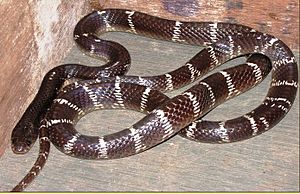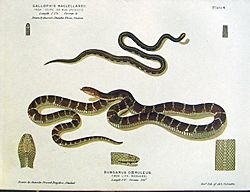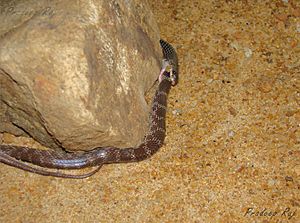Common Krait facts for kids
Quick facts for kids Common krait |
|
|---|---|
 |
|
| Scientific classification | |
| Kingdom: | |
| Phylum: | |
| Subphylum: | |
| Class: | |
| Order: | |
| Suborder: | |
| Family: | |
| Genus: | |
| Species: |
B. caeruleus
|
| Binomial name | |
| Bungarus caeruleus (Schneider, 1801)
|
|
| Synonyms | |
|
Pseudoboa caerulea Schneider, 1801 |
|
The common krait (Bungarus caeruleus), also known as Indian krait or blue krait) is a species of venomous snake of the genus Bungarus found in the jungles of the Indian subcontinent. It is a member of the "big four" species, inflicting the most snakebites on humans in India.
Description
The average length is 0.9 m (3.0 ft), but they can grow to 1.75 m (5 ft 9 in). Males are longer, with proportionately longer tails. The head is flat and the neck hardly evident. The body is cylindrical, tapering towards the tail. The tail is short and rounded. The eyes are rather small, with rounded pupils.
Distribution and habitat
This species is found in Peninsular India from Sindh (Pakistan), to the West Bengal plains. It occurs throughout South India and Sri Lanka at elevations up to about 1600 m. It is also recorded from Afghanistan, Bangladesh, and Nepal.
Its range comprises a wide variety of habitats. It is found in fields and low scrub jungle, as well as inhabited areas. It is known to take up residence in termite mounds, brick piles, rat holes, even inside houses. It is frequently found in water or in proximity to a water source.
Feeding
The common krait feeds primarily on other snakes, including: "blind worms" (snakes of the genus Typhlops); and cannibalizes on other kraits, including the young. It also feeds on small mammals (such as rats, and mice), lizards and frogs.
Behavior
Behavioral differences during day and night time have been reported in B. caeruleus. During the day, it is sluggish and generally docile. It often hides in rodent holes, loose soil, or beneath debris, so is rarely seen. It often rolls its body into a loose, coiled ball, keeping its head well concealed. When in this 'balled' condition, the snake allows considerable handling, but over handling often instigates bites.
However, at night, the snake is very active and escapes by hissing loudly, or keeping still, occasionally biting the source of the annoyance.
When agitated, it will coil up with its head concealed and body flattened, and makes jerky movements. It may also lift its tail. It is reluctant to bite, but when it does, it typically holds on for a while, which enables it to inject considerable amounts of venom. It may become aggressive at night if threatened.
Venom
The common krait's venom consists mostly of powerful neurotoxins, which induce muscle paralysis. Clinically, its venom contains presynaptic and postsynaptic neurotoxins, which generally affect the nerve endings near the synaptic cleft of the brain.
Kraits are nocturnal, so seldom encounter humans during daylight hours; incidents occur mainly at night. Frequently, little or no pain occurs from a krait bite, and this can provide false reassurance to the victim. Typically, victims complain of severe abdominal cramps, accompanied by progressive paralysis. Once bitten, the absorption of the venom into the victim can be considerably delayed by applying a pressure bandage to the bite site (using about the same tension as one uses for a sprained ankle) and immobilising the area.
Images for kids
See also
 In Spanish: Krait común para niños
In Spanish: Krait común para niños





